Halloween, a holiday celebrated annually on October 31, is synonymous with carved pumpkins grinning with eerie smiles, children dressed in spooky costumes excitedly going door-to-door for trick-or-treats, and a general atmosphere of lighthearted frights. But where did this globally recognized celebration actually begin? The origins of Halloween are deeply rooted in ancient traditions and beliefs, evolving significantly over centuries into the holiday we recognize today. Let’s delve into the captivating history of Halloween and trace its journey from pagan festivals to modern-day festivities.
The Ancient Celtic Roots: Samhain and the Veil Between Worlds
The most prominent origin story of Halloween takes us back to ancient Celtic cultures, over 2,000 years ago. It was during this era that the festival of Samhain (pronounced “SAH-win”) emerged. Samhain was a pivotal event in the Celtic calendar, marking the end of summer and the harvest, and the beginning of the dark, cold winter – a season often associated with death. For the Celts, who primarily resided in the region of modern-day Ireland, the United Kingdom, and northern France, Samhain was not just an end but also a beginning, a transition into a new year.
This transition was believed to blur the lines between the worlds of the living and the dead. On the night of Samhain, Celts believed that the veil between the living world and the spirit world thinned, allowing the ghosts of the dead to return to earth. This was not necessarily seen as a joyous occasion. The presence of these spirits could cause trouble and damage crops. To ward off these harmful ghosts, Celts built massive sacred bonfires, where people gathered to burn crops and animals as sacrificial offerings to Celtic deities. During the celebrations, Celts would wear costumes, typically consisting of animal heads and skins, and attempt to tell each other’s fortunes.
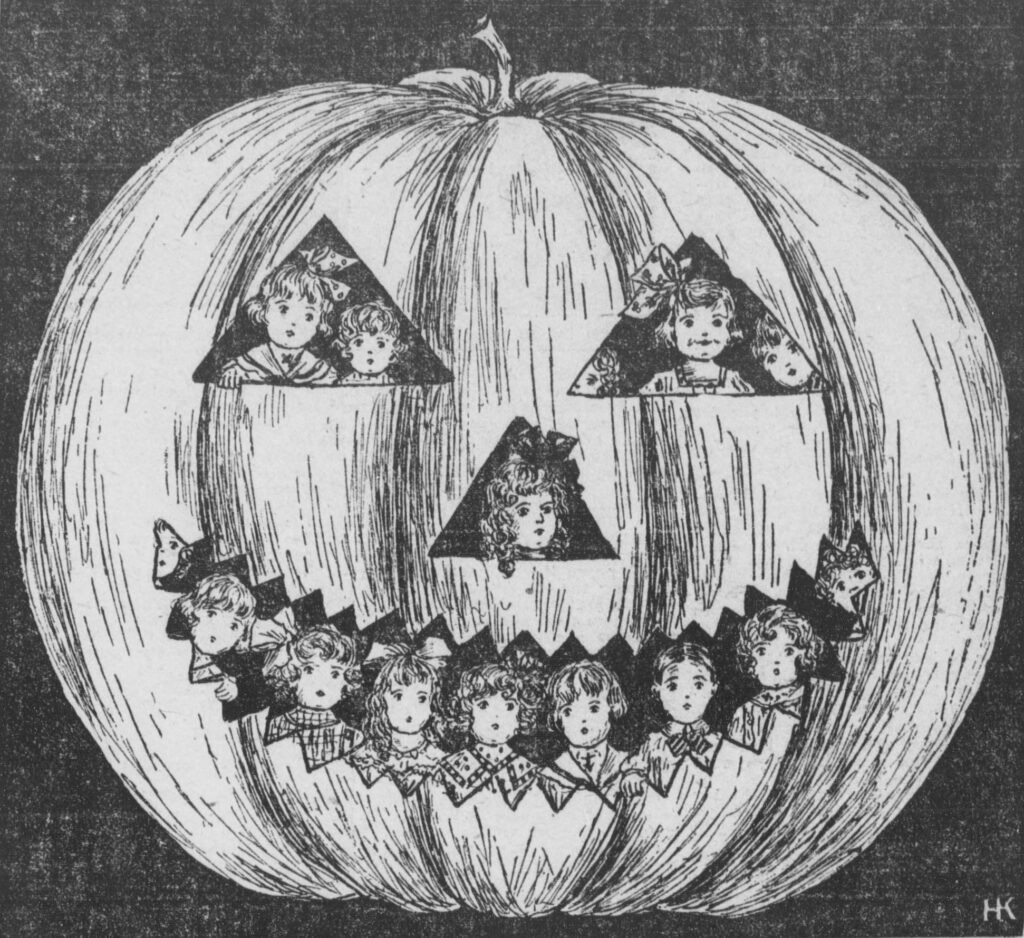 An image detail from a 1910 newspaper showing a large jack-o-lantern, illustrating the early association of pumpkins with Halloween.
An image detail from a 1910 newspaper showing a large jack-o-lantern, illustrating the early association of pumpkins with Halloween.
The Christian Influence: All Saints’ Day and All Souls’ Day
As Christianity spread across Europe, it gradually absorbed and adapted many pagan festivals. By the 8th century, Pope Gregory IV designated November 1st as a time to honor Christian saints and martyrs. This day was named All Saints’ Day, also known as All Hallows’ Day. The evening before was naturally called All Hallows’ Eve, and later, Halloween.
The placement of All Saints’ Day around the same time as Samhain was not coincidental. It is widely believed that the Church strategically chose this date to replace the pagan festival with a Christian observance, facilitating the conversion process and blending existing traditions with Christian beliefs. All Saints’ Day incorporated some of the existing Samhain traditions, particularly those related to honoring the dead.
Following All Saints’ Day, All Souls’ Day was later introduced on November 2nd. This day was specifically dedicated to commemorating all of the faithful departed. The proximity of these Christian holidays to Samhain further cemented the association of late October and early November with themes of death, spirits, and the supernatural, shaping the evolving traditions of Halloween.
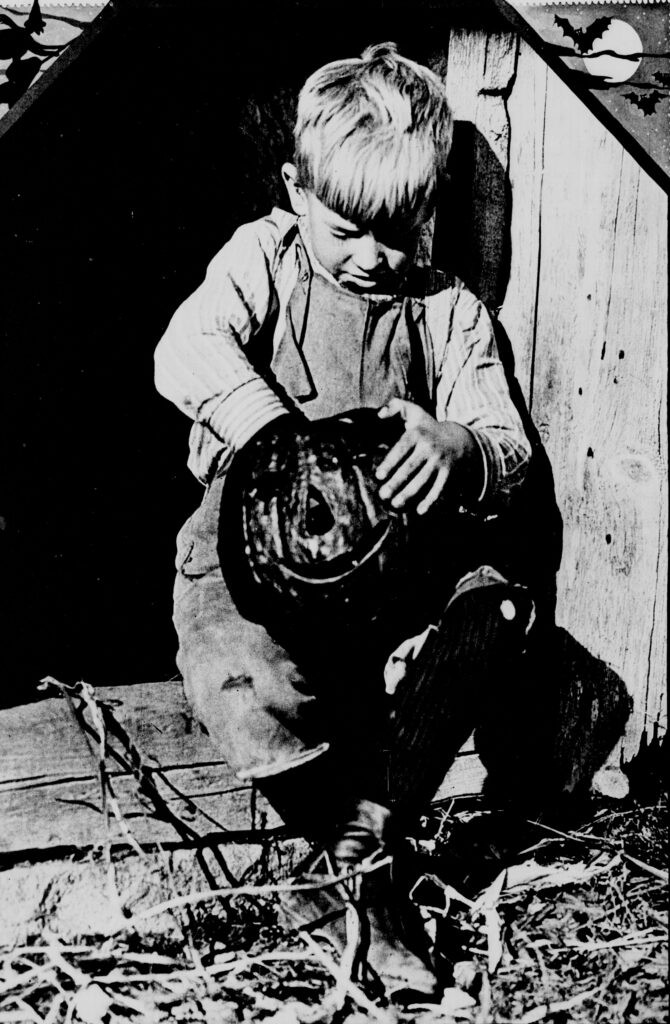 Image detail from a 1915 newspaper depicting a boy carving a pumpkin, showcasing the early American tradition of pumpkin carving for Halloween.
Image detail from a 1915 newspaper depicting a boy carving a pumpkin, showcasing the early American tradition of pumpkin carving for Halloween.
Classic Halloween Traditions: From Ancient Beliefs to Modern Customs
Many of the Halloween traditions we cherish today can be traced back to these ancient Celtic and early Christian influences. Let’s explore the origins of some of the most iconic Halloween customs:
Carving Jack-o’-Lanterns: From Turnips to Pumpkins
The practice of carving Jack-o’-Lanterns is perhaps one of the most recognizable symbols of Halloween. However, the original Jack-o’-Lanterns weren’t pumpkins at all, but turnips. This tradition originated in Ireland and is rooted in a folk tale about a man named Stingy Jack. According to the legend, Jack tricked the Devil multiple times and was ultimately denied entry into both Heaven and Hell. As a result, he was condemned to wander the earth for eternity with only a burning coal to light his way, which he placed inside a carved-out turnip.
The Irish used these turnip lanterns during Samhain to ward off evil spirits and Stingy Jack himself. When Irish immigrants arrived in North America, they found pumpkins to be more readily available and easier to carve than turnips. Pumpkins quickly replaced turnips as the vegetable of choice for creating spooky lanterns, cementing the Jack-o’-Lantern as a quintessential Halloween symbol.
Seeing Ghosts and the Supernatural: Echoes of Samhain Spirits
The pervasive association of Halloween with ghosts and the supernatural is a direct legacy of Samhain. The Celtic belief that the veil between worlds thinned during Samhain, allowing spirits to roam the earth, is the foundational concept behind the ghostly imagery of Halloween. The later Christian holidays of All Saints’ Day and All Souls’ Day, with their focus on saints and the departed, further reinforced this theme of contact with the spirit world around this time of year. This historical context is why ghosts, skeletons, and other spooky figures remain integral to Halloween decorations and costumes.
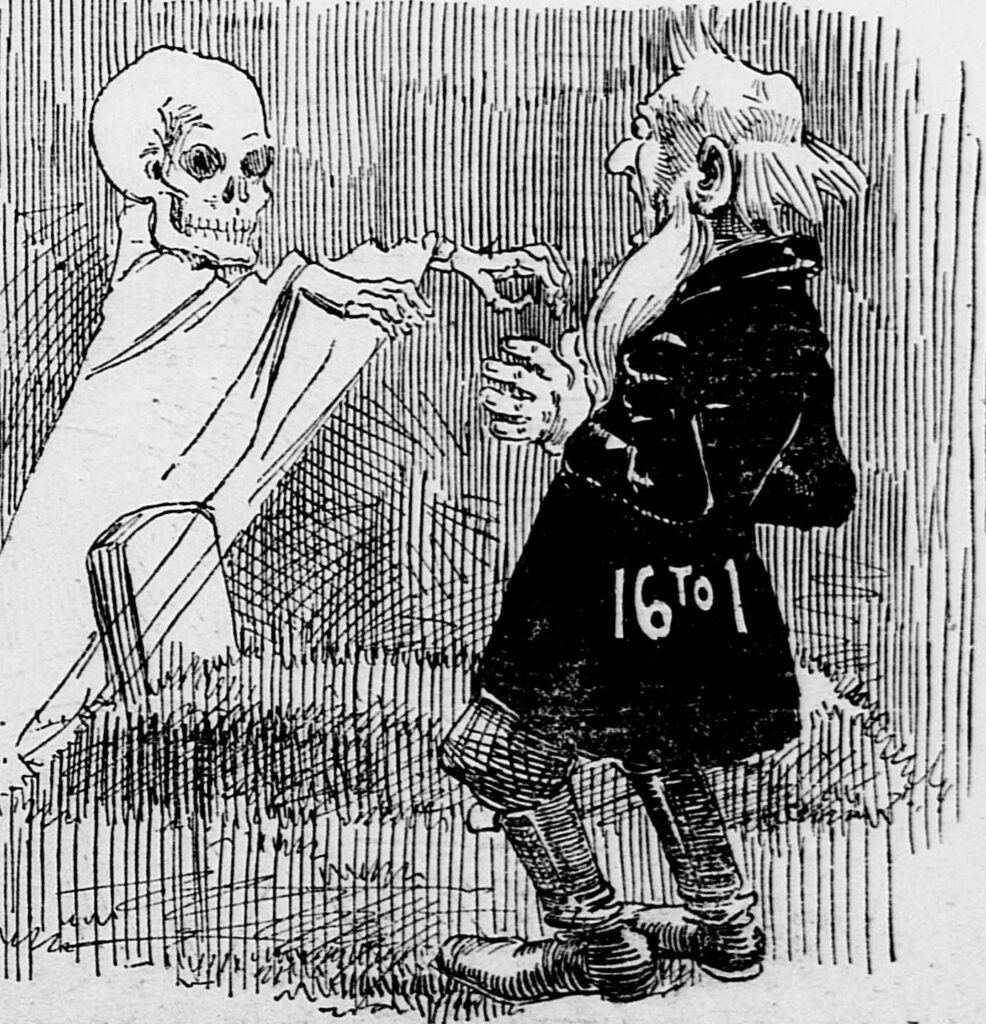 Cartoon from an 1896 newspaper showing a man encountering a ghost, illustrating the long-standing association of ghosts with Halloween.
Cartoon from an 1896 newspaper showing a man encountering a ghost, illustrating the long-standing association of ghosts with Halloween.
Wearing Scary Costumes: Disguising from Spirits
The tradition of wearing scary costumes on Halloween also has its roots in the ancient Celtic festival of Samhain. As Celts believed that spirits roamed freely on Samhain night, they began to wear costumes, often made of animal skins and heads. The purpose of these disguises was twofold: to confuse and ward off evil spirits, preventing them from harming or possessing the living, and to mimic the spirits themselves, perhaps as a form of appeasement or camouflage.
This practice of dressing up to avoid malevolent spirits evolved over time. While the original intention was to blend in with or frighten away supernatural entities, the modern costume tradition is more about playful fright and creative expression. However, the underlying connection to spirits and the otherworld remains embedded in the act of donning costumes on Halloween.
Trick-or-Treating: From Appeasing Spirits to Candy Collection
Trick-or-treating, a beloved Halloween activity for children, has a complex history with several possible origins. One theory links it back to the Samhain tradition of leaving out food and treats to appease the spirits wandering the earth. Over time, this practice may have evolved into people impersonating these spirits and going door-to-door to receive offerings, a precursor to modern trick-or-treating.
Another theory points to the medieval European practice of “souling” and “guising.” On All Souls’ Day, the poor, often children, would go “souling,” visiting homes to receive “soul cakes” in exchange for prayers for the dead. “Guising” was a Scottish and Irish secular custom where people, often in disguise, would go door-to-door reciting verses, singing songs, or performing tricks in exchange for food or coins. This practice gradually shifted away from religious connotations and incorporated more secular entertainment.
A third possible influence is “belsnickeling,” a German-American Christmas tradition where costumed figures would visit homes, testing residents to guess their identities in exchange for treats. These various traditions, blending and evolving over centuries and across cultures, likely converged to form the modern American custom of trick-or-treating, with its emphasis on costumes and candy.
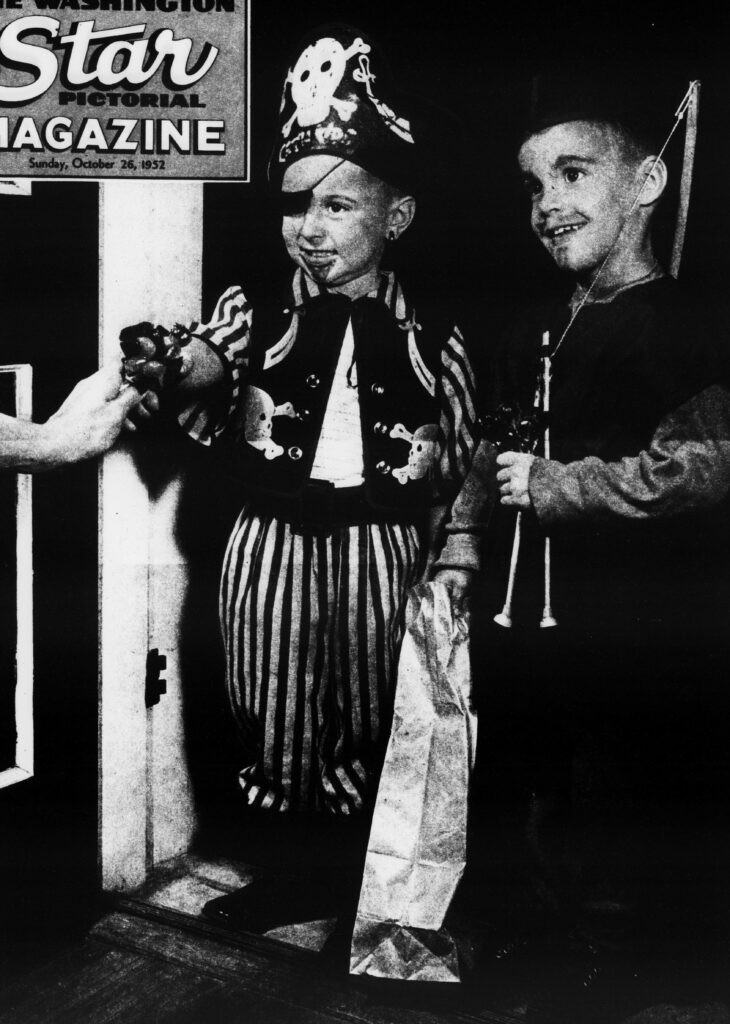 Image of children trick-or-treating in costume, illustrating the quintessential modern Halloween tradition of trick-or-treating for candy.
Image of children trick-or-treating in costume, illustrating the quintessential modern Halloween tradition of trick-or-treating for candy.
Black Cats, Black and Orange Colors, Bobbing for Apples, and More
Many other Halloween symbols and traditions also have interesting historical roots:
-
Black Cats: Associated with bad luck and witchcraft, black cats gained their spooky reputation during the Middle Ages when they were linked to the Devil and witches’ familiars.
-
Black and Orange: These classic Halloween colors are thought to derive from Samhain, with black representing the “death” of summer and orange symbolizing the autumn harvest.
-
Bobbing for Apples: This fun Halloween game has origins in a Roman courting ritual associated with the festival of Pomona, the Roman goddess of fruit trees. When the Romans conquered Celtic lands, Pomona’s festival blended with Samhain.
-
Pranks and Mischief Night: Pranks associated with Halloween may stem from various sources, including May Day celebrations and the general spirit of mischief associated with festivals involving spirits and the blurring of worlds. “Mischief Night” became a pre-Halloween tradition brought to America by Irish and Scottish immigrants.
-
Candles and Bonfires: The tradition of lighting candles and bonfires is directly linked to Samhain bonfires, which were meant to guide spirits and offer protection. Candles are a modern, safer adaptation of these large flames.
-
Candy Apples: While the practice of coating fruit in syrup is ancient, candy apples as a Halloween treat are believed to be a more recent invention from the early 20th century in America, becoming popular as Halloween treats in the early 1900s.
-
Bats: Bats’ association with Halloween is partly due to their natural presence around bonfires (attracted to insects), linking them to the Samhain celebrations. Medieval folklore further cemented their spooky image with superstitions about bats as omens of death.
-
Candy Corn: This iconic Halloween candy, originally called “Chicken Feed,” emerged in the late 19th century in America and became associated with Halloween as trick-or-treating gained popularity in the mid-20th century.
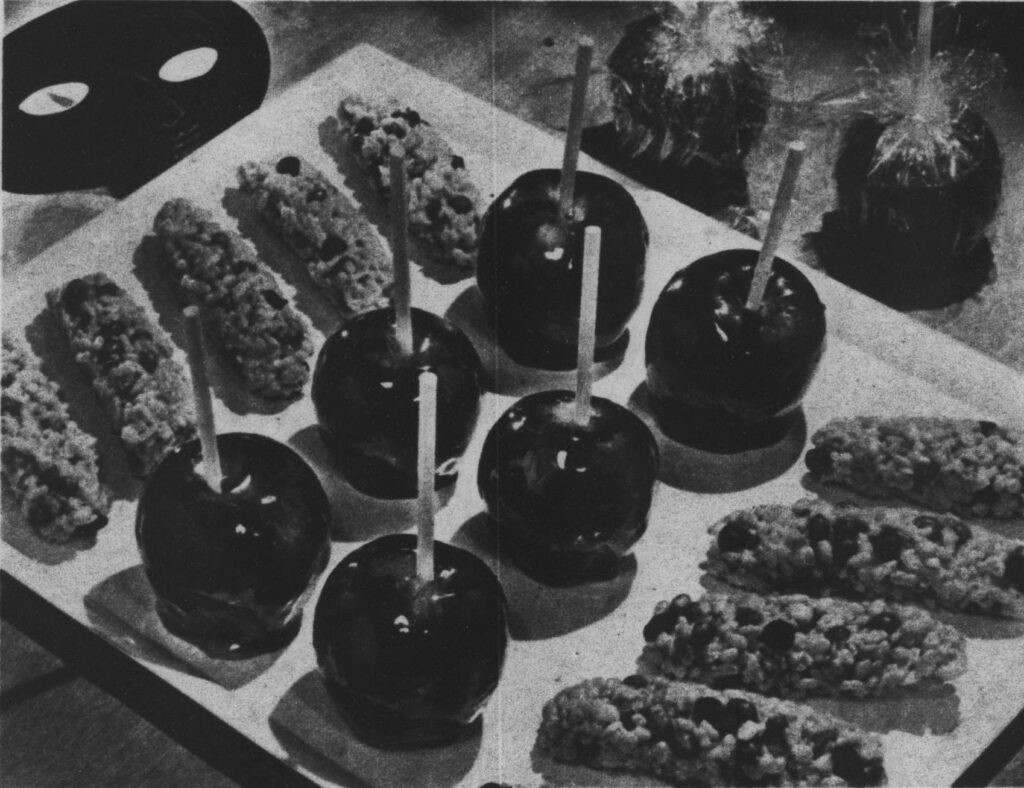 Image detail from a 1956 newspaper showing candy apples, illustrating the evolution of Halloween treats to include candied fruits.
Image detail from a 1956 newspaper showing candy apples, illustrating the evolution of Halloween treats to include candied fruits.
From Ancient Fires to Modern Fun: The Enduring Spirit of Halloween
From its ancient Celtic origins as the festival of Samhain to its evolution through Roman and Christian influences, and its transatlantic journey to America, Halloween has transformed significantly over the centuries. What began as a serious pagan ritual focused on marking seasonal change and warding off spirits has evolved into a largely secular holiday centered around community, costumes, candy, and lighthearted scares.
Despite its transformations, Halloween retains echoes of its ancient past. The themes of death, spirits, and the supernatural, while now often playful and theatrical, are still central to the holiday’s identity. Halloween’s enduring popularity speaks to our fascination with the mysterious and the unknown, and our enduring human need to mark the passage of time with rituals and celebrations. So, as you enjoy your Halloween festivities this year, remember the long and fascinating journey of this holiday, tracing back to ancient bonfires and the beliefs of Celtic ancestors.


